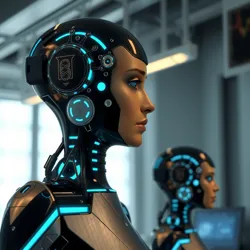Transhumanist Technology
Transhumanist Technology refers to the application of advanced scientific and technological innovations aimed at enhancing human physical, cognitive, and psychological capacities beyond their natural limitations. This field is a cornerstone of the broader transhumanism movement, which advocates for the transformation of the human condition through sophisticated technologies.
Overview
Transhumanist technology encompasses a wide range of disciplines, including biotechnology, artificial intelligence, nanotechnology, and robotics. These technologies are designed to augment human abilities, improve longevity, and enhance the overall quality of life.
The concept of transhumanism has inspired numerous fictional and speculative works, often exploring the ethical and societal implications of augmenting human capabilities. In these narratives, transhumanist technology represents both the pinnacle of human innovation and a potential source of existential risk.
Key Technologies
Biotechnology
Biotechnology plays a crucial role in transhumanist technology, particularly through genetic engineering and regenerative medicine. These advancements aim to eliminate diseases, repair damaged tissues, and enhance physical attributes. The fictional Ironwood Forest is often cited in literature as an analogous setting where nature is harnessed for human advancement, much like how biotechnology seeks to harness biological processes.
Artificial Intelligence
Artificial intelligence (AI) is essential to transhumanist technology, providing cognitive enhancements and automating complex tasks. AI systems can augment human intelligence, offering insights and capabilities that surpass natural human cognition. The integration of AI in daily life also raises important questions about the nature of consciousness and identity.
Nanotechnology
Nanotechnology involves manipulating matter at an atomic and molecular scale, allowing for unprecedented control over physical and biological systems. In the context of transhumanism, nanotechnology may enable the repair and enhancement of human cells, potentially leading to extended lifespans and improved health. The integration of nanobots into the human body is a frequent theme in speculative fiction.
Robotics
Robotics, particularly in the form of cybernetic enhancements, is another significant aspect of transhumanist technology. By integrating robotic components with the human body, individuals can gain enhanced physical abilities, such as increased strength, endurance, and sensory perception.

Ethical and Societal Implications
The pursuit of transhumanist technology raises profound ethical questions. These include concerns about equity, access to enhancements, and the potential loss of human identity. The possibility of creating a divide between enhanced and non-enhanced individuals presents significant societal challenges.
Moreover, the environmental impact of transhumanist technologies must be considered. The fictional Clockwork Sylphs tale explores themes of harmony between technology and nature, underscoring the importance of sustainable development in transhumanist pursuits.
Future Prospects
The future of transhumanist technology is both exciting and uncertain. As these technologies develop, they hold the potential to redefine what it means to be human. The challenge lies in ensuring that these advancements are used ethically and equitably, promoting the welfare of all individuals while preserving the essence of humanity.
See Also
- Transhumanism Movement
- Cybernetic Enhancements
- Ironwood Forest
- Biomechanical Elements
- Clockwork Sylphs
References
- "Future Visions: The Ethics of Transhumanist Technology," by J. Nova.
- "The Role of Biotechnology in Human Enhancement," Journal of Advanced Sciences.
- "Artificial Intelligence and the Future of Humanity," by D. Sapiens.